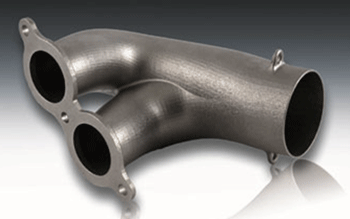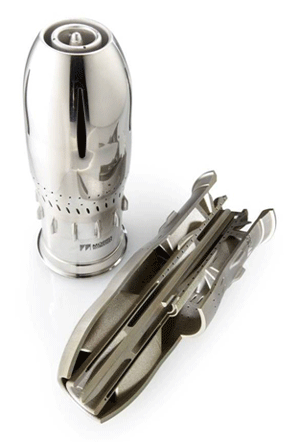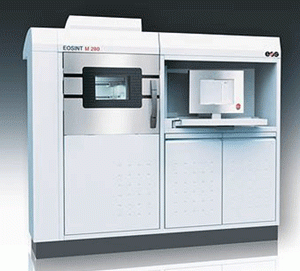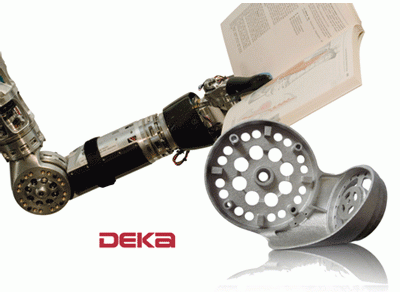Laser sintering – versatile production of tooling inserts, prototype parts and end products from metal powder
The process
DMLS works by laser-sintering very fine layers of metal powders on a layer-by-layer basis allowing the gradual build-up of a metallic structure. Medium to small size part structures can be grown in a matter of hours and days depending on size, and the DMLS machine can work unattended, 24 hours a day.
In a typical DMLS cycle a ‘first layer’ of fine metal powder is deposited onto a platform inside the laser-sintering system, 20µ particle size is said to be ideal for obtaining extremely fine detail and component features. The first layer is sintered using a powerful diode pump fibre optic laser which is precisely controlled in the X and Y coordinates to achieve the desired part shape and tolerances. The platform then lowers by the particle size of the next powder layer and a fresh layer of powder is deposited onto the previously sintered layer. The new layer is then laser-sintered to create a bond with the previous sintered one.
The laser-sintered components obtain their microstructures and mechanical properties either directly through the DMLS process or through subsequent conventional heat treatment or finishing. For example, a maraging steel material similar to a H13 tool steel manufactured by DMLS can have both a coarse and fine structure, depending on processing conditions and powders used, and excellent chemical and mechanical properties have been achieved through laser-sintering of titanium alloys, stainless steels, tool steels, and nickel-base superalloys.
EOS Electro Optical Systems GmbH
EOS Electro Optical Systems GmbH based in Krailling, near Munich, Germany, was founded in 1989 to exploit the new technology of stereolithography and later developed DMLS technology, particularly for metals. Today EOS claims to be the world’s leading manufacturer of laser sintering systems. The company employs around 300 people worldwide, 250 of them in Krailling, and had sales in 2009 of approximately 60 million Euros. EOS has expanded its portfolio over the past 20 years for e-Manufacturing of components from a wide range of materials including metals, plastics, thermoplastics, and moulding sand. To date EOS has sold nearly 300 laser-sintering systems for metals.
At the recent EuroMold exhibition in Frankfurt, Germany (December 1-4, 2010) EOS exhibited its new EOSINT M 280 machine (Fig.1) which is the updated and further improved version of the EOSINT M 270, said to be the leading system on the market for laser sintering of metal components. The EOSINT M 280 system is optionally equipped with a solid state laser of 200, or an optional 400 watt, and an optimized Gas Management System operating in both protective nitrogen and argon atmospheres to guarantee optimal and consistent processing conditions for highest and constant part building qualities.
Peter Klink, Executive Vice President Global Sales at EOS, states: ‘The new system sets new standards in terms of part quality and reproducibility, at the same time improving cost-effectiveness and user-friendliness. The EOSINT M 280 adopts all features and advantages of the well-established EOSINT M 270 system, and makes it even more attractive for a wide range of demanding applications including tooling and series production.’ An important improvement of the EOSINT M 280 compared to its predecessor is the increase of the maximum building height up to 325 mm. This enables taller parts to be placed in the process chamber, again expanding the application areas. This is particularly interesting for hybrid part building, a concept which EOS introduced in the 1990s for prototype tooling. In the hybrid process, complex parts are produced by building additional material on top of a prefabricated part.
EOS also sees significant potential for laser sintering to produce medical products. ‘Medical companies are already using our technology to create patient-specific products which are uniquely tailored to an individual’s anatomy and needs’ said Martin Bullemer, Business Development Manager – Medical at EOS at the MedTec exhibition in Stuttgart in 2010. ‘As our quality and production controls continue evolving, designers and manufacturers will be able to achieve ever more extraordinary advances in patient care and comfort’, he said. DMLS systems are currently used to create stainless steel prototypes for customized spinal surgical instruments, cobalt chrome replacement knee joint prototypes, end-product dental copings and bridges, and titanium dental implants with porous surfaces that promote osteointegration. A DEKA prosthetic device produced by laser-sintering is shown in Fig.2.
Metal Powder Range for Laser Sintering Expanding

Fig.3 The photo shows an exhaust manifold laser-sintered
from EOS NickelAlloy IN625 (Source EOS and Morris
Technologies Inc.)
In conjunction with the development of its laser sintering systems, EOS has also developed a number of metal powder materials with the specific aim of producing parts with ‘standardized part property profiles’(PPPs) by DMLS. EOS ensures maximum reliability by subjecting all the relevant powder products to an intensive process development procedure and constant quality assurance. One such material is EOS NickelAlloy IN625 which Peter Klink states will open up completely new fields of application. EOS says the new nickel superalloy has high tensile strength, excellent processability and uniform corrosion resistance. It is targeted at aerospace, chemical, marine and motor sport applications. A laser-sintered exhaust manifold made from EOS NickelAlloy IN625 is shown in Fig.3.
The exhaust manifold part is made by Morris Technologies Inc. (MTI) in Cincinnati, Ohio, which was one of the first companies in the USA to install EOS laser-sintering equipment in 2003. MTI is said to be the largest supplier of direct metal laser-sintered (DMLS) parts worldwide – operating ten machines nine of which feature the latest generation of DMLS technology. Greg Morris, CEO of Morris Technologies said: ‘We are using IN625 with DMLS to build complex aerospace parts for high temperature and high-strength applications. The process achieves material properties that are comparable to wrought metals and far exceed casting’.

industry (Source EOS and Morris Technologies Inc.)
MTI is also using laser sintering for EOS titanium grades Ti-64 and Ti64ELI – to produce complex geometries for aerospace and medical applications. EOS Titanium Ti64 is a pre-alloyed Ti6AlV4 alloy in fine powder form. This well-known light alloy is characterised by having excellent mechanical properties and corrosion resistance combined with low specific weight and biocompatibility. EOS Titanium Ti64 fulfills the requirements of ASTM F1472 regarding maximum concentration of impurities. Parts built from EOS Titanium Ti64 can be machined, spark-eroded, welded, micro shot-peened, polished and coated if required. Unexposed powder can be reused.
Other powders available for DMLS include EOS Cobalt-Chrome, StainlessSteel GP1 (17-4) and PH1 (15-5), Inconel 718 and 625, DirectMetal 20, and Aluminium.
www.eos.info
www.morristech.com
See also:
Additive Manufacturing – machine builders state their case
New study looks at the potential of direct metal laser sintering technology to generate energy and raw material savings
The development of titanium applications via additive manufacturing
News | Articles | Market reviews | Search directory | Subscribe to e-newsletter







